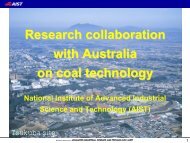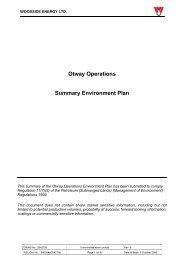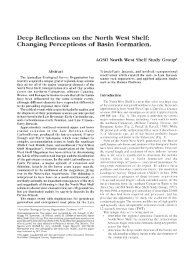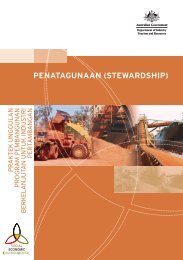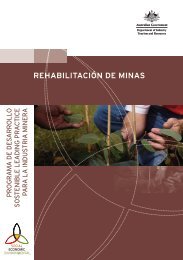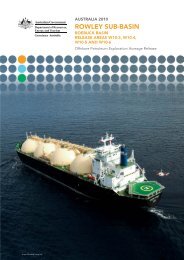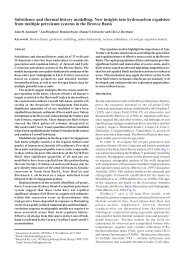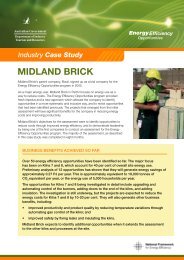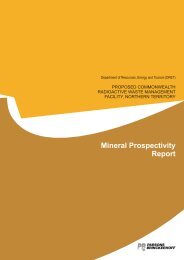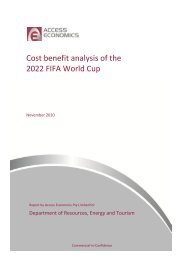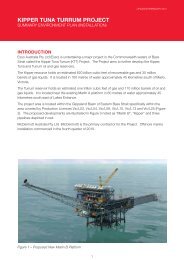A guide to leading practice sustainable development in mining
A guide to leading practice sustainable development in mining
A guide to leading practice sustainable development in mining
You also want an ePaper? Increase the reach of your titles
YUMPU automatically turns print PDFs into web optimized ePapers that Google loves.
Websites: The <strong>in</strong>ternet is effective for provid<strong>in</strong>g general <strong>in</strong>formation about the project and provid<strong>in</strong>g<br />
‘real time’ updates on activities and progress. Some stakeholders may prefer the option of engag<strong>in</strong>g<br />
through this technology or at least have the option of ga<strong>in</strong><strong>in</strong>g <strong>in</strong>formation this way.<br />
Workshops and focus groups: Workshops enable company personnel <strong>to</strong> work with a variety of<br />
stakeholders <strong>to</strong> bra<strong>in</strong>s<strong>to</strong>rm solutions <strong>to</strong> issues raised by the community that may not have been<br />
adequately considered <strong>in</strong> project design.<br />
Research: Various forms of research, whether undertaken directly by the company or operation,<br />
or commissioned from a third party, can provide valuable <strong>in</strong>formation about community needs and<br />
perceptions about the facility. A range of research methods may be used, from surveys and focus<br />
groups <strong>to</strong> <strong>in</strong>terviews.<br />
Scheduled personal visits: Face-<strong>to</strong>-face discussions are important for establish<strong>in</strong>g personal rapport<br />
with key <strong>in</strong>dividuals, such as fence l<strong>in</strong>e neighbours.<br />
Open days and site visits: These activities are a valuable mechanism for keep<strong>in</strong>g the community<br />
and families of employees up-<strong>to</strong>-date about the operation and how it is be<strong>in</strong>g managed. Such events<br />
also provide an opportunity <strong>to</strong> hear about community concerns and issues. Site visits for particular<br />
stakeholder groups are a more focused and targeted option and can often serve <strong>to</strong> demystify what<br />
happens at a project.<br />
Staff membership on community groups and committees: Develop<strong>in</strong>g l<strong>in</strong>ks between m<strong>in</strong><strong>in</strong>g<br />
operations and other community groups can help community understand<strong>in</strong>g about the project, and also<br />
help the project understand more about community priorities and sentiments about the operation.<br />
Employee <strong>in</strong>teraction: Employees are a valuable resource for understand<strong>in</strong>g community concerns and<br />
issues. They are also one of the most important ambassadors of the company and need <strong>to</strong> be engaged<br />
with <strong>in</strong> a variety of ways, from <strong>to</strong>olbox talks <strong>to</strong> more structured employee forums.<br />
Key steps for <strong>susta<strong>in</strong>able</strong> community <strong>development</strong><br />
His<strong>to</strong>rically, the <strong>in</strong>dustry’s contribution <strong>to</strong> the community was often managed by<br />
outside planners without the <strong>in</strong>volvement of people <strong>in</strong> the local community. Planners,<br />
who may have been m<strong>in</strong><strong>in</strong>g company managers, consultants or government officials<br />
from national or state/terri<strong>to</strong>ry governments, tended <strong>to</strong> <strong>in</strong>form communities of what<br />
programs were available for them and sought their agreement rather than their<br />
participation. International <strong>lead<strong>in</strong>g</strong> <strong>practice</strong> <strong>in</strong> community <strong>development</strong>—<strong>in</strong>clud<strong>in</strong>g<br />
World Bank requirements—calls for communities <strong>to</strong> be <strong>in</strong>cluded <strong>in</strong> plann<strong>in</strong>g processes,<br />
and encouraged and supported <strong>to</strong> participate <strong>to</strong> the extent of their <strong>in</strong>terest and<br />
capabilities. Involv<strong>in</strong>g community members, both women and men, <strong>in</strong> the actual<br />
plann<strong>in</strong>g stages of <strong>development</strong> programs, will make success much more likely.<br />
Development work is complex and fluid <strong>in</strong> nature, and can be approached <strong>in</strong> diverse<br />
ways, but there are some logical steps.<br />
Step 1: Dialogue<br />
The first step starts with community engagement, preferably <strong>in</strong>corporat<strong>in</strong>g<br />
elements from third and fourth generation engagement (see Table 3.2). Dialogue<br />
for community <strong>development</strong> should not have an explicit agenda other than <strong>to</strong><br />
understand the needs and expectations of people. It should seek <strong>to</strong> establish trust<br />
and confidence <strong>in</strong> the process. Without this, <strong>development</strong> work has no basis <strong>to</strong><br />
move forward. This first step of ga<strong>in</strong><strong>in</strong>g understand<strong>in</strong>g <strong>in</strong>cludes undertak<strong>in</strong>g socioeconomic<br />
basel<strong>in</strong>e studies and social impact assessments, as discussed earlier.<br />
A GUIDE TO LEADING PRACTICE SUSTAINABLE DEVELOPMENT IN MINING 71



